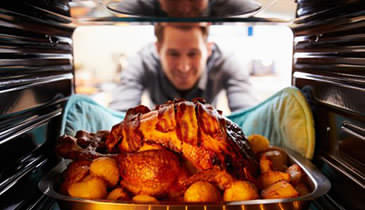 Source: Livestrong
Source: Livestrong
We’ve all done it: stared at the fridge for a full five minutes, but then ordered pizza. “Waiting until the last minute to choose what we are eating can lead to poor choices because we really can’t make sound decisions when we are running from one place to the next and don’t have the tools to create a healthy choice,” says Florida-based registered dietician Jaime Mass, owner of Jaime Mass Nutritionals.
But if you do the cooking in advance, you’ll not only eat healthier, you’ll also save time and money, says Casey Moulton, founder of Kitchen Karate, an approach to home cooking that allows you to make 15 different meals in two hours. Ready to take a stab at meal prep? Start with these 13 easy tips.
1. Cook once a week.
Pick one day a week and do the bulk — if not all — of your shopping and cooking. It might sound like a big time commitment, but doing everything at once means you only have to preheat the oven once, chop your meats and veggies once and clean your kitchen once, says Karate Kitchen’s Casey Moulton. For instance, chopping all the ingredients for one meal takes about 10 minutes. However, chopping all your ingredients for 15 meals at once takes about 40 minutes, Moulton says. That’s a huge time saver! However, resist the temptation to cook two, three or four weeks in advance. Most cooked meals tend to stay fresh in your fridge for about a week.
2. Keep it simple.
“Try recipes that are practical, easy to follow and have familiar ingredients,” says chef Candice Kumai, author of “Cook Yourself Sexy.” After all, you’re trying to simplify your life, not master the fine art of sushi rolling. “Make sure that you stay within your range of comfort,” she says. “Start with recipes that only have a few steps and a few ingredients that you love.” Once you start to feel more confident in your abilities, try rotating in a slightly more complicated dish from time to time. It’ll help you expand your skill set and enjoy new recipes without adding a ton of stress.
3. Consider each food’s timeline.
Some foods are a bit more sensitive to the passing of time than are others. Berries and greens like spinach and arugula, for instance: They get mushy fast. So, it’s typically best to eat them earlier in the week, says nutritionist Jaime Mass. Also, if you’re prepping salads, they’ll stay crisp longer if you store any dressings and oils in a separate container, says chef Candice Kumai. She also notes that kale holds up better than thinner salad greens. When you’re ready to dig in, just drizzle and eat.
Also, while you might like avocado in your salad or sliced apples for a snack, you should hold off slicing and dicing them until you’re ready to eat them.
4. Fill your freezer.
Even with meal prep as plan A, life happens. From time to time, you’ll run out of prepped food in your fridge. That’s when it’s handy to have a half-dozen prepped meals stored in your freezer, says nutritionist Jaime Mass. “Most meats that are already cooked can last in the freezer from two to six months. Soups also store well in the freezer, and you can split them into single servings to store for up to three months,” Mass says. So grab a permanent marker and write eat-by dates on them. If you don’t want to write directly on your Tupperware, you can put the containers in freezer bags and then write the dates on them.
5. Use the slow cooker.
Whether you have a crazy schedule, don’t have much faith in your cooking abilities or just love juicy, flavor-packed dishes, slow cookers are amazing, says nutritionist Jaime Mass. Don’t have one? It’s time to invest. While small 2.5-quart slow cookers are good options for people who are tight on cabinet space, seven-quart ones can cook upwards of 10 meals at once. All you have to do is plug in the cooker, throw in some chopped veggies, meat, spices and liquid and walk away.
Most recipes call for slow-cooking the ingredients between four and eight hours — meaning you can cook your meals while you’re out running errands, at work or even asleep.
6. Don’t dismiss frozen produce.
Bags of frozen broccoli and blueberries aren’t just convenient, they’re surprisingly nutritious. According to 2013 research from the University of Chester in England, the vast majority of frozen produce is higher in antioxidants and other nutrients than is fresh produce. For instance, in the study, frozen carrots were found to have about three times the lutein and twice the beta-carotene, as well as greater levels of vitamin C and polyphenols, compared with their fresh counterparts. “They are picked at their peak of freshness and flash frozen so they don’t lose nutrition during transport from farm to store,” says nutritionist Jaime Mass.
7. Go ahead, repeat meals.
So what if meal prepping means you eat four Greek yogurt parfaits in a week? “It isn’t a bad thing to repeat meals, especially if it helps keep you on track and you enjoy the food you’re eating,” says nutritionist Jaime Mass. After all, making a big batch of a dish and dividing it up to eat throughout the week is a simple time-saver.
However, to keep yourself from getting bored, you might want to mix up what meals you repeat each week, Mass says. For instance, one week you may want to make a huge batch of quinoa salad and another week an enormous pot of turkey chili.
8. Don’t forget snacks!
Just because it’s called “meal” prep doesn’t mean you should only prep full-blown entrees, says nutritionist Jaime Mass. It can help to plan out snacks too. After all, some of the worst dietary decisions happen at work while stressed and hungry. By stocking your desk drawer with a week’s worth of snacks in single-serving containers, you can help fight the temptation, Mass says.
Crackers, almonds and dried fruit are all great, nonperishable options. But resist the temptation to buy single-serving snack packs. Bite per bite, they cost more than regular-size boxes, and just because they come in 100-calorie packs doesn’t mean they’re healthy, says chef Candice Kumai. If you have an office fridge — and trust your co-workers not to steal your food — you can also bring in perishable snacks like yogurt, cheese, baby carrots and bell pepper slices.
9. Use ingredients in multiple recipes.
For cooking newbies, shopping for exact recipes can prove helpful. But for those who are prepared to take some creative license with their food, looking for ingredients you can use in a variety of dishes can save you time and money, says Kitchen Karate’s Casey Moulton. For example, if you buy a whole bunch of tomatoes, cook them and divide them up to use in pastas, wraps and salads. You can save on cooking time and keep from throwing away your money. “Go into the store knowing how many servings of proteins, grains and vegetables you need,” he says. When you get home, get creative to use up everything you’ve purchased.
10. Form an assembly line.
Rather than prepping and cooking each meal individually, focus on cooking everything all at once — just do it in stages. After all, pretty much every ingredient will require some combination of washing, chopping, seasoning and cooking. So as soon as you get home from the grocery store, rinse every ingredient that needs it, and then get slicing, dicing and chopping, says Kitchen Karate’s Casey Moulton.
Next, fire up all four of your stove’s burners and use both of your oven racks to cook up to six ingredients at once. If you have more than six ingredients to cook, just rotate them in once the other ones are done. Then, all you have to do is mix and match to make your dishes.
11. Spice it up!
When you’re eating chicken three days in a row, spices are vital to beating taste-bud boredom, says Kitchen Karate’s Casey Moulton, who uses one or more of the following in each of his meals: salt, pepper, onion, garlic and olive oil. They’re among the world’s most versatile flavoring agents and create a tasty palate for adding more herbs and spices.
A sprinkle of basil in one dish and a dash of curry in another can make two seemingly similar chicken-and-onion dishes taste wildly different, Moulton says. Bonus: Herbs and spices are full of health-boosting antioxidants and are great for adding flavor to meals without increasing your sodium intake, says nutritionist Jaime Mass. Take a stroll down the spice aisle and stock up.
12. Upgrade your kitchen tools.
Seasoned meal preppers can benefit from investing in the right tools, says Kitchen Karate’s Casey Moulton. For instance, think about your pots and pans: Can you fit them all on your stove at the same time? If so, you can cook more food in less time.
Moulton also recommends storing your pantry’s oils and vinegars in labeled spray and squeeze bottles for easy and lightning-fast handling. (Plus, you’re less likely to overuse calorie-dense oils if you’re spraying them rather than pouring them out of a bottle.) Resealable plastic containers can also come in handy when storing grains like rice, quinoa and couscous. On each lid, write any pertinent cooking instructions. It’s so much easier than dealing with boxes, bags and clothespins.
13. Organize your fridge.
Pack your fridge with completed meals to eat throughout week, says Kitchen Karate’s Casey Moulton. To make it even easier, he recommends dedicating each shelf in your fridge for a different meal: breakfast, lunch and dinner. If you want to take some thought out of the whole “What lunch should I bring to work today?” conundrum, consider labeling each meal with the date you plan to eat it. That way you can eat from the front of your fridge to the back. Plus, if you plan when you’ll eat each meal, you can make sure that each days’ proteins, grains, fruits and veggies are varied.




